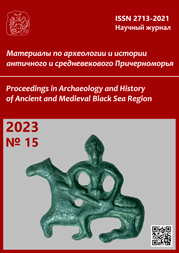Римские и ранневизантийские моливдовулы с бюстами правителей на обеих сторонах как источник исторической информации
Roman and early Byzantine bullae with busts of rulers on both sides as source of historical information
Author(s): Mikhail M. ChorefSubject(s): History, Ancient World, Middle Ages
Published by: Нижневартовский государственный университет
Keywords: history; archaeology; sphragistics; Rome; Byzantium; Caracalla; Procopius;
Summary/Abstract: There are two hanging seals in our field of vision, the generally accepted attribution of which has not yet been developed. Both on the obverse and the reverse of the unepigraphic seal of Roman origin, highly artistic, embossed and realistically executed busts are imprinted depicting bearded emperors crowned with laurel wreaths; the short-bearded one is most likely Caracalla, while the long-bearded one is presumably Septimius Severus. The portraits on both sides of the second seal seem to depict another pair of Roman sovereigns, since they are represented wearing cuirasses and military cloaks and diadems. To render the images, the official style of iconic representation was used, which was popular in the Roman Empire since the time of Constantine I. The attribution of the second seal is also facilitated by the fact that on its obverse and reverse, remains of the legends have been observed, wherein it is possible to restore the names “Julian” and “Procopius”. The conclusion is that the first seal was stamped under Caracalla and the second one under Procopius; here is the clear evidence of reigning emperors appealing to the authority of their ancestors.
Journal: Материалы по археологии и истории античного и средневекового Причерноморья
- Issue Year: 2023
- Issue No: 15
- Page Range: 997-1008
- Page Count: 12
- Language: Russian

